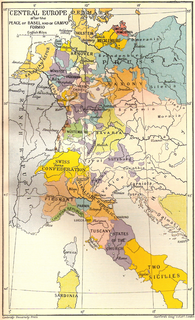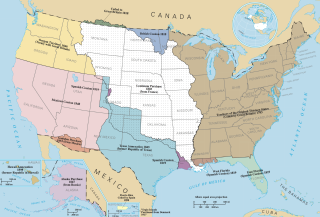 W
WThe Act of Mediation was issued by Napoleon Bonaparte, First Consul of the French Republic on 19 February 1803 establishing the Swiss Confederation. The act also abolished the previous Helvetic Republic, which had existed since the invasion of Switzerland by French troops in 1798. After the withdrawal of French troops in July 1802, the Republic collapsed. The Act of Mediation was Napoleon's attempt at a compromise between the Ancien Régime and a republic. This intermediary stage of Swiss history lasted until the Restoration of 1815. The Act also destroyed the statehood of Tarasp and gave it to Graubunden.
 W
WThe Treaty of Amiens temporarily ended hostilities between France and Great Britain during the French Revolutionary Wars. It marked the end of the French Revolutionary Wars; after a short peace it set the stage for the Napoleonic Wars. Britain gave up most of its recent conquests; France was to evacuate Naples and Egypt. Britain retained Ceylon and Trinidad. It was signed in the city of Amiens on 27 March 1802 by Joseph Bonaparte and Marquess Cornwallis as a "Definitive Treaty of Peace." The consequent peace lasted only one year and was the only period of general peace in Europe between 1793 and 1814.
 W
WThe Treaty of Aranjuez (1801) was signed on 21 March 1801 between France and Spain. It confirmed a previous secret agreement in which Spain agreed to exchange Louisiana for territories in Tuscany.
 W
WThe Treaty of Campo Formio was signed on 17 October 1797 by Napoleon Bonaparte and Count Philipp von Cobenzl as representatives of the French Republic and the Austrian monarchy, respectively. The treaty followed the armistice of Leoben, which had been forced on the Habsburgs by Napoleon's victorious campaign in Italy. It ended the War of the First Coalition and left Great Britain fighting alone against revolutionary France.
 W
WThe Concordat in Alsace-Moselle is the part of the Local law in Alsace-Moselle relating to the official status accorded to certain religions in these territories.
 W
WThe Concordat of 1801 was an agreement between Napoleon and Pope Pius VII, signed on 15 July 1801 in Paris. It remained in effect until 1905. It sought national reconciliation between revolutionaries and Catholics and solidified the Roman Catholic Church as the majority church of France, with most of its civil status restored. The hostility of devout French Catholics against the revolutionary state had then largely been resolved. It did not restore the vast church lands and endowments that had been seized upon during the revolution and sold off. Catholic clergy returned from exile, or from hiding, and resumed their traditional positions in their traditional churches. Very few parishes continued to employ the priests who had accepted the Civil Constitution of the Clergy of the Revolutionary regime. While the Concordat restored much power to the papacy, the balance of church-state relations tilted firmly in Napoleon's favour. He selected the bishops and supervised church finances.
 W
WThe Convention of 1800, also known as the Treaty of Mortefontaine, was signed on September 30, 1800 by the United States of America and France. The difference in name was due to Congressional sensitivity at entering into treaties, due to disputes over the 1778 treaties of Alliance and Commerce between France and the US.
 W
WThe Convention of El Arish was signed on 24 January 1800 by representatives from France and the Ottoman Empire in the presence of a British representative. It was intended to bring to an end the French campaign in Egypt and Syria, with the repatriation of French troops to France and the return of all territory to the Ottomans.
 W
WThe Treaty of Den Haag was signed on May 16, 1795 between representatives of the French Republic and the Batavian Republic. Based on the terms of the treaty, the Batavian Republic ceded to France the territories of Maastricht, Venlo, and Zeelandic Flanders. Moreover, the accord established a defensive alliance between the two nations, which rapidly involved the Netherlands in the war against Great Britain and Austria. Furthermore, the Dutch agreed to pay an indemnity of 100 million guilders for their part in the war of the First Coalition, and to provide the French Republic a large loan against a low rate of interest. The "barrier forts" in the former Austrian Netherlands were dismantled. The port of Flushing was to be placed under a co-dominion. Finally, in a secret clause, the Dutch agreed to pay for a French army of occupation of 25,000 till the war was ended.
 W
WThe Treaty of Leoben was a general armistice and preliminary peace agreement between the Holy Roman Empire and the First French Republic that ended the War of the First Coalition. It was signed at Eggenwaldsches Gartenhaus, near Leoben, on 18 April 1797 by General Maximilian von Merveldt and the Marquis of Gallo on behalf of the Emperor Francis II and by General Napoléon Bonaparte on behalf of the French Directory. Ratifications were exchanged in Montebello on 24 May, and the treaty came into effect immediately.
 W
WThe 1801 Treaty of Madrid was signed on 29 September 1801 by Portugal and France. Portugal made territorial concessions to France in Northern Brazil, closed its ports to British shipping and paid an indemnity of 20 million francs.
 W
WThe Treaty of Paris of 15 May 1796 was a treaty between the French Republic and the Kingdom of Piedmont-Sardinia during the War of the First Coalition.
 W
WThe Peace of Basel of 1795 consists of three peace treaties involving France during the French Revolution.The first was with Prussia on 5 April; The second was with Spain on 22 July, ending the War of the Pyrenees; and The third was with the Landgraviate of Hesse-Kassel on 28 August, concluding the stage of the French Revolutionary Wars against the First Coalition.
 W
WThe Third Treaty of San Ildefonso was a secret agreement signed on 1 October 1800 between the Spanish Empire and the French Republic by which Spain agreed in principle to exchange its North American colony of Louisiana for territories in Tuscany. The terms were later confirmed by the March 1801 Treaty of Aranjuez.
 W
WThe Treaty of Lunéville was signed in the Treaty House of Lunéville on 9 February 1801. The signatory parties were the French Republic and Holy Roman Emperor Francis II. The latter was negotiating both on his own behalf as ruler of the hereditary domains of the Habsburg Monarchy and on behalf of other rulers who controlled territories in the Holy Roman Empire. The signatories were Joseph Bonaparte and Count Ludwig von Cobenzl, the Austrian foreign minister.